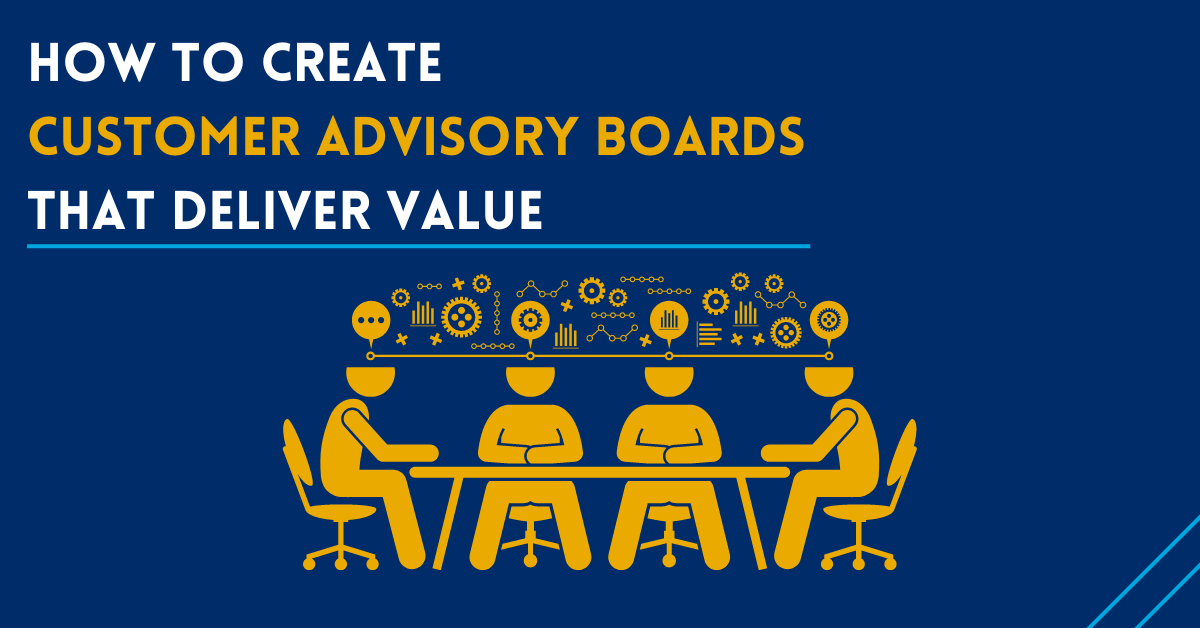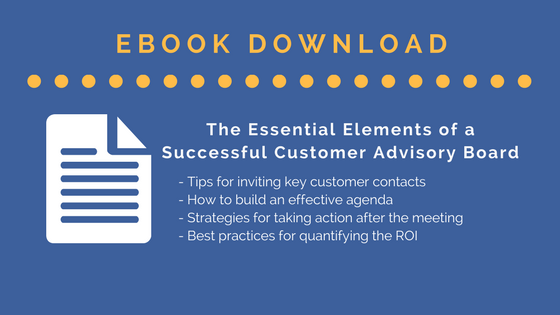If you’ve been following our blog series on Customer Advisory Board (CAB) best practices, you’ve seen that we’ve covered a wide range of topics. This includes tips for making your first a CAB a success, how to compel key customers to join your CAB, and establishing the meeting agenda. But there are still a few critical considerations for running a Customer Advisory Board.
Customer Advisory Board Meeting Logistics
Location
When planning your Customer Advisory Board, it’s important not to overlook the location for your meeting. We recommend that companies select a location that your Customer Advisory Board members will find both nice and convenient. This doesn’t mean it needs to be at a five-star resort close to a major airport, but asking them to fly to a secondary city (often via a connecting flight), then driving an hour to a mediocre hotel surely will not be well received.
Meeting Room
Don’t forget to think about the meeting room space. It should easily accommodate the size of your group, with seating arranged in a way that promotes conversation. We’ve found that a large “U-shape” conference table works best for our clients. Try to find a room with good lighting (preferably natural) and all the equipment you will need for the meeting, including a projector, recording devices, and possibly a couple of flip charts for notes or other purposes.
Outings
When scheduling post-meeting social activities, be sure they are relatively close to the resort. A 45-minute bus ride back to the hotel after dinner can result in a late night and tired CAB members the next day.
Recording
We also suggest that you consider recording the entire meeting. This way, nothing is lost, and your colleagues can focus on the conversation instead of taking notes. If you choose to record the meeting, be sure to check with your CAB members in advance to ensure they are comfortable with doing so. It is essential that you receive candid, unfiltered input from your customers. Anything that might serve to inhibit that is problematic.
Taking Action after the Customer Advisory Board Meeting
The final ingredient to a successful Customer Advisory Board program also happens to be one of the most important. Simply, it focuses on the question – “What happens after the CAB meeting has concluded?”
If you’ve followed our recommendations thus far, it is a near certainty that you received immensely valuable feedback and suggestions from some of your most important customers.
As with any voice-of-customer program, it is vital that your company takes the appropriate steps to capitalize on what you’ve learned or validated. While this may seem obvious to most, this step is neglected all too often.
Following are a few suggestions that should help:
1. Review the CAB Meeting with Your Colleagues
Get your team together for a “post mortem” within a few days after the meeting. Discuss what everyone heard, what the near-term and longer-term priorities should be, and schedule a series of meetings for the team to convene over the following few weeks to dig in.
It’s also valuable to reflect on how the day went and what can be improved upon for the next meeting.
2. Ask Customer Advisory Board Members for Feedback
Prepare a brief survey to send to the customers in attendance. The survey, which should go out within a day or two of the event, can request feedback on the discussion topics, accommodations, logistics and their perception of the value of the event.
It’s also a good idea to inquire about what your CAB members feel your company should focus on. Chances are, they heard or expressed several things that would constitute a wish list for your team to consider. Give them one final opportunity to convey what they think your priorities should be.
3. Be Sure to Thank Your CAB Members
Send a thank-you note to CAB members within a week of the event. The note shouldn’t just thank them for their time and valuable feedback, but highlight some of the key takeaways from the day’s conversations.
Your customers won’t be expecting you have everything detailed or an action plan completed so quickly, but sharing some high-level bullets identifying what your team will be focused on over the coming months would be well received.
4. Create a CAB Championship Team
Assemble one or two internal teams of mid to senior level people who are empowered to address the prominent themes from your CAB meeting. Try to staff the team with folks passionate about service excellence, and who are known to be change agents who can get things done.
It’s also beneficial to include a person or two familiar with process improvement, root cause and change management strategies. Have them develop project plans for each initiative and require them to report back on their progress on a regular basis.
5. Don’t Forget to Follow Up with Customer Advisory Board Members
Identify a cadence for updating your CAB members on how your internal activities are progressing. Your updates can be by email, conference calls, web meetings, a formal letter, or even a web page that only CAB members have access to.
Be sure to include those who were in attendance as well as those who are part of the CAB but couldn’t attend due to a conflict. Many companies strive to update CAB members every month or two, so the lines of communication are kept open. Waiting until the next CAB meeting to share what you’ve accomplished is not optimal, and may cause your members to question your commitment.
Use the CAB as an opportunity to strengthen relationships and provide clear evidence that your company greatly values customer feedback. Doing so should result in the creation of extremely loyal customers that will help your business in a variety of ways.
Quantifying the ROI from your Customer Advisory Board Program
Now that we’ve covered many of the determinants of a successful CAB program, there is one final recommendation I’d like to offer. If you have been deliberate in your planning and execution, your Customer Advisory Board should be a meaningful source of revenue for your company. Therefore, it’s important to devise ways to quantify the return on investment (ROI) of your CAB program.
Satrix Solutions research shows that ROI can take several different forms. Specifically, our clients have seen those CAB members:
- Increase spending at a faster rate than non-CAB members, on average
- Churn at a much lower rate
- Serve as references more often
- Refer at higher rates
- Participate in Marketing activities more frequently, such as developing case studies, offering testimonials, or speaking on your behalf at events.
- Agree to test new services or products before they are more widely released to the market
- Provide more thoughtful and detailed feedback on your offering, value proposition, strategic vision, etc.
- Will share more competitive intelligence they’ve heard or otherwise been exposed to
So, while the time you spend with your Customer Advisory Board members will undoubtedly help to strengthen your personal relationships, the program should certainly help to drive quantifiable business benefits as well. Measuring the impact on your company will serve as undeniable evidence that the investments you are making are driving real value.
If you would like more information on how to create a Customer Advisory Board that will deliver real value to your organization, contact us today.


